Consulting Case Interview Questions
Cracking the Case Interview: Your Guide to Sample Questions and Answers
Consulting is among the most sought profession by business management graduates. The top three consulting firms are abbreviated as MBB (McKinsey, Boston Consulting Group, and Bain), also known as the Big Three.

Since most consultancy firms work on various kinds of problems, they look to hire people with the best critical thinking abilities who can tackle challenges faced by their clients by applying well-known frameworks for problem-solving.
Hence, most consulting firms rely on case studies as a crucial part of the interview process. Nailing these case studies can be the difference between landing a role as a consultant or leaving empty-handed from an interview.
However, most case studies can be solved with existing frameworks like Porter’s five forces, SWOT analysis, and the 4 Ps. Learning these frameworks and walking through them during the interview helps differentiate yourself as a star candidate.
We strongly believe it’s a great place to start your preparation before investing in our more comprehensive Consulting Case Interview Course, which features more than 2,000 questions.
Consulting Case Interview Tips
- Prepare to be assessed on your thinking and problem-solving abilities.
- Familiarize yourself with frameworks like Porter's five forces and SWOT analysis.
- Note essential information and critical relationships in the case study.
- Use proven approaches and frameworks to analyze and answer questions during the interview.
- Candidates are evaluated on demeanor, structure, communication, math proficiency, and creativity.
Consulting Case Interview Example
Every case study interview starts by providing some background information on the case, which helps you understand the problem you are tasked with finding a solution to. It is essential to separate the necessary information from the useless ones, as this skill is highly sought after.

Also, make sure to note down all the critical relationships between the date provided. For example, suppose the case first mentions that profits have been declining, and later mentions something about reducing marketing costs.
In that case, it’s a good idea to jot down that it might be a factor in lowering profits (reduction in marketing costs means lower revenue, which in turn means lower yields).
For this sample case, we will use the example of Cali Cable and present it just like how an interviewer would.
Sample Case Prep: Cali Cable
Cali Cable is a small business that operates in northern California. Their core business is installing cable infrastructure in residential neighborhoods so that the homes have access to cable television. Cali Cable has manufactured its own cable since it has been in existence.

However, the factory is out of date and must be shut down. The CEO does not want to open a new factory because it will be expensive, costing as much as $15 per foot of cable. Therefore, he is considering outsourcing cable manufacturing from either a local supplier, an Asian supplier, or an Eastern European supplier.
He is experiencing problems with the local supplier, so he asked the COO to find the most cost-effective way to find a reliable cable supplier elsewhere. You are assigned to work with the COO to find the best course of action.
Sample Consulting Interview Questions and Frameworks
Based on the case study above, the interviewer will proceed to ask you questions that test your critical thinking and analysis skills. Hence, it is very important to properly understand the case first, ask the right questions, and follow a proven approach.

1. How should the COO approach outsourcing?
Framework: A 2x2 for an outsourcing case is a valuable framework.
- For the x-axis competitiveness, the candidate should consider Cali Cable’s effectiveness in terms of costs.
- For strategic importance, the candidate should think about how the cable is important to the company’s overall goals. For example, how is the quality of an outsourced line going to threaten customer satisfaction?
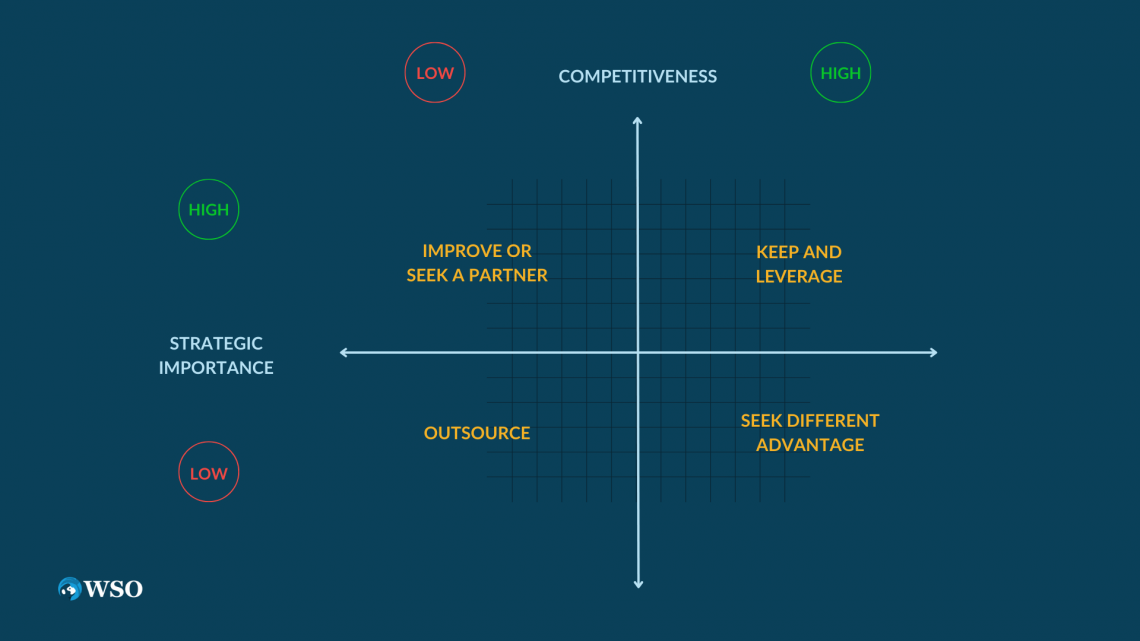
The candidate should also consider the costs and risks of outsourcing. The tree below could be useful.
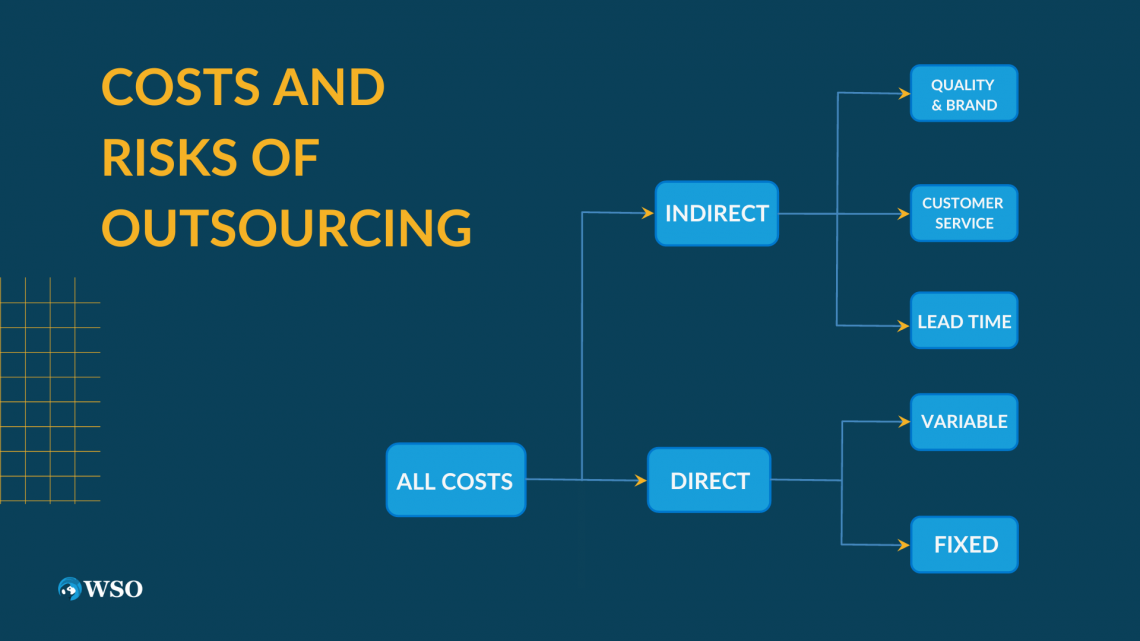
2. The COO approaches you. She has collected some data and wants you to analyze it and prepare a PowerPoint presentation slide for a meeting with the CEO. The template for the slide is as follows.
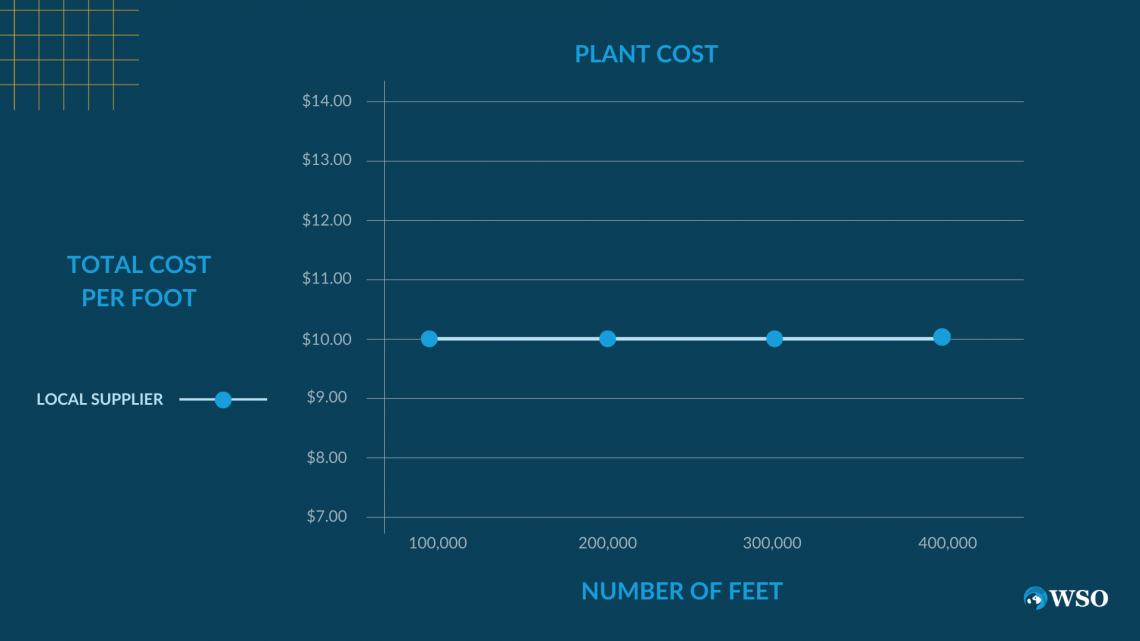
The COO has found that the Asian supplier will charge $7 per foot of cable with a fixed payment of $600,000 per year. The Eastern European supplier will charge $6 per foot of cable and $800,000 in fixed costs. Complete the blank slide for the COO plotting the total cost per foot for the two different options for 100K, 200K, 300K, and 400K feet.
Answer: The candidate is instructed to create her own slide on her scratch paper.
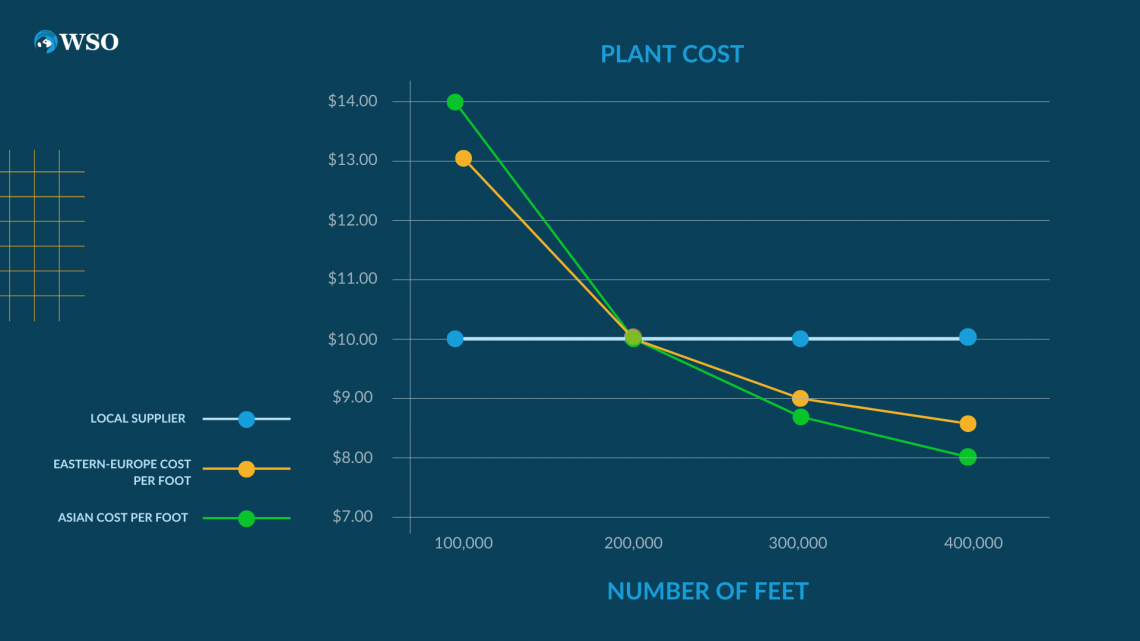
You should immediately recognize the economies of scale resulting from the fixed cost structure of the two outsourcing options. If not, try to explain the graph. All three plants cost $10 per foot at 200,000 units, but the Asian and Eastern European plants enjoy the benefits of scale beyond this point.
The Eastern European plant becomes the clear cost leader past 200,000 units.
3. The COO thinks she has a good feel for demand based on historical data. She calls you and says, ‘for the past few years, Cali Cable has used about 50 miles of cable per year, so we’ll order 50 miles of cable from our new supplier for next year.’ What should you tell her?
or
Considering the standard deviation and service level, how much cable should be ordered annually? How much will Cali Cable save compared to the local supplier if it goes with the Eastern European option?
Answer: Because the COO wants to satisfy demand 98% of the time, the 400,000 feet of cable is the relevant footage on the x-axis of the cost graph. With the Eastern European plant costing $8 per foot for 400,000 units, Cali Cable will save $800,000 per year ($2 times 400K feet).
4. What else should the COO consider to reduce costs?
Answer: Consider at least four different options. We have highlighted the four below:
- Warehouse: store any excess supply in a warehouse and adjust order levels for the next year. Inventory carrying costs should be compared to the costs of mismatching supply and demand.
- Increase the number of orders: annual orders result in costs from stock-outs or excess supply. If Cali Cable can order throughout the year, it can better match supply and demand.
- Shorten lead times: this could also fall under increasing the number of orders. Shorter lead times from the supplier to Cali Cable will allow them to postpone ordering and have more information about demand forecasts.
- Explore other options and suppliers: for example, when demand exceeds supply, locate excess capacity at other cable operations or use the local supplier at $10 per foot when the cable is needed. This allows Cali Cable to order less.
- Better forecasting: find a more accurate way to forecast demand or have customers commit to quantities in advance.
5. What are some of the risks to outsourcing to Asia or Eastern Europe?
Answer: There are many different risks to consider. We have named a few below under the relevant bucket.
- Product Risks:
Will the cable be compatible with American cables and televisions? Are there any risks to the cable becoming obsolete? With the growth in high definition, 3D, and internet television, the supplier needs to be able to stay up to date with technology. - Company Risks:
Is the Eastern European or Asia supplier a sustainable company that will be able to deliver into the future? If Cali Cable sources exclusively from a new supplier, their fortunes are tied. - Operational Risks:
Will the new supplier be successfully integrated with the supply chain logistics at Cali Cable? Are there any risks to shipping cable from Europe or Asia? Will it be shipped via boat or plane? What are the lead times? How reliable is this company in delivering on time? - Customer Service Risks:
Will the quality of the cable meet the customer’s expectations? What are the risks to over or under-ordering cable?
6. Using the PowerPoint slide you prepared with the COO, present your recommendation to the CEO.
Recommendation: The CEO wants the most cost-effective supplier, but the candidate should also mention the reasons behind the decision and the risks involved. A possible recommendation:
“For our cost structure to remain competitive, it looks like outsourcing is the best option. As long as the outsourced cable meets our quality standards, it appears to align with our corporate strategy. Cali Cable should consider outsourcing its cable from Eastern Europe because it is a low-cost option.
Show the PowerPoint slide. Due to the fixed cost structure, Cali Cable will enjoy economies of scale with both offshore options, but Eastern Europe appears to be the most attractive. Cali Cable will save $800,000 per year compared to the local supplier and $200,000 per year compared to the Asian supplier.
Before proceeding, I’d like to find out more about the risks associated with the Eastern European supplier, such as their reliability, quality, ordering processes, and ability to integrate with our supply chain.”
This free guide covers one whole case study question from start to finish and will drastically improve your chances of securing an offer with your dream job. You can find more tips, tricks, and examples in the free Case Interview Guide created by our friends at Management Consulted.
How are management consulting case interviews graded?
Interviewers usually grade the candidates over a variety of qualities using a scale ranging from 1 to 10, with one meaning poor and ten meaning star.
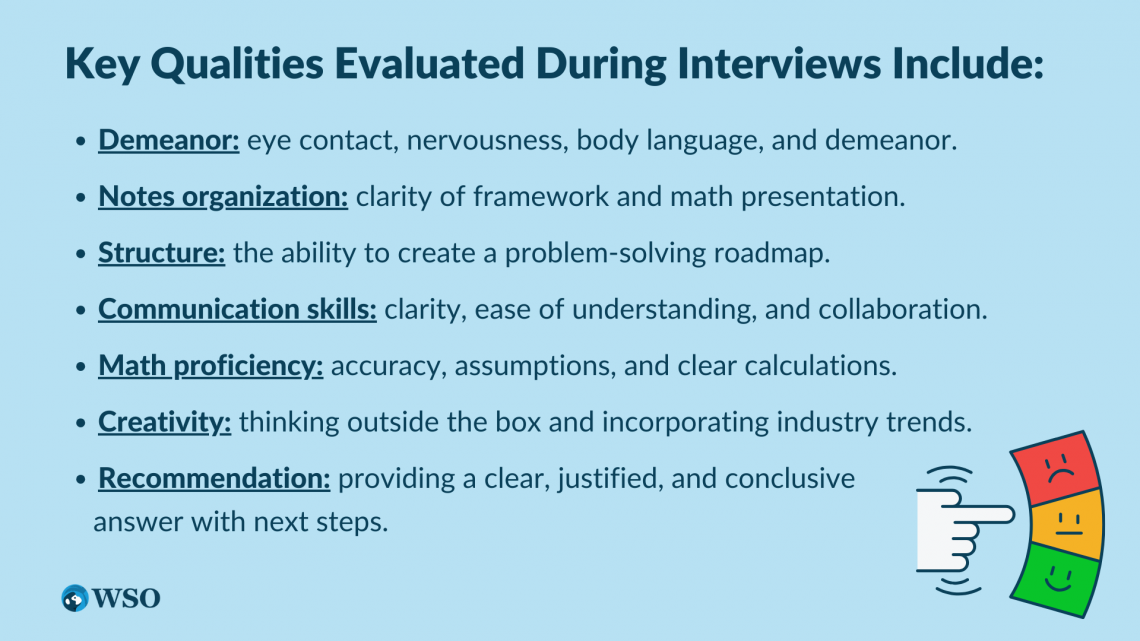
We look into the various qualities that are evaluated, as well as questions used to measure them. These questions should give you a good feel for what you need to focus on to ace these consulting interview cases.
Demeanor
- Did she maintain eye contact?
- Did she fidget during the interview?
- Did she appear nervous?
- Did she smile and appear relaxed?
Notes
- Was the framework clearly presented on the page?
- Was the math organized and easy to follow on the page?
- Did she keep track of key findings?
Structure
- Did the framework provide a road map to solve the case?
- Did she “bucket” or categorize any lists or ideas?
- Did she follow the cadence of clarify, structure, solve, and recommend?
Communication
- Did she speak clearly throughout the interview?
- Was it easy or difficult to follow her ideas?
- Did she try to work with you as a partner in solving the case?
Math Proficiency
- Did she correctly complete all math problems?
- Did she use appropriate assumptions or clarify any ambiguity?
- Did she think out loud so that you could follow the calculations?
Creativity
- Did she think outside the box?
- Did she mention any current events or recent trends affecting the industry?
Recommendation
- Did she answer the question?
- Was the conclusion clear, confident, and to the point?
- Did she justify the conclusion with the key findings?
- Did she include “next steps” as though she would finish the case?
Full WSO Consulting Case Interview Prep Guide & Additional Resources
The case study covered in this free guide was obtained directly from WSO’s very own Consulting Case Interview Guide, which features:
- 2,037 questions across 209 consulting firms
- 11 challenging cases authored by McKinsey Associate
- Five critical frameworks for case interview success
Think about it - if this page alone can set you miles ahead of the competition, imagine what our complete course can do for you.
The WSO Case Interview Course will guide you through each step of the interview process and ensure you’re in the strongest position to land the job at a top-tier consulting firm. Check it out below!
Free Resources
To learn more about interviews and the questions asked, please check out the additional interview resources below:


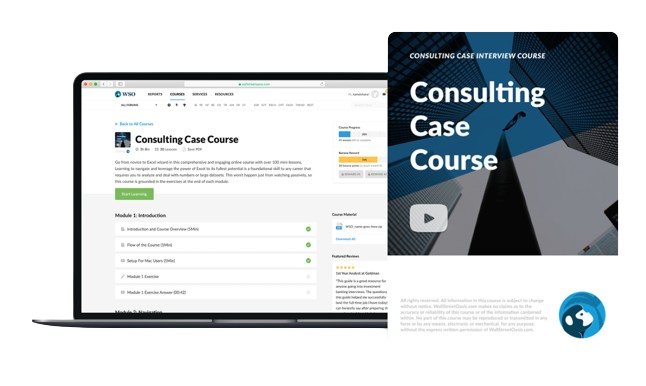

or Want to Sign up with your social account?